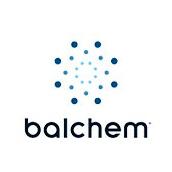Integrating New Techniques for an Improved Reproduction Program
Published: February 15, 2014
By: Ricardo Chebel (University of Minnesota)and Todd Bilby, Ph.D. (Merck)
Introduction
Currently, reproductive failure is the first reason for involuntary culling, which stresses the economic importance of improving fertility. Estrous synchronization programs have been researched extensively since the mid 1990’s (Pursley et al. 1995; Moreira et al., 2001; Dewey at al., 2010) with the main objective of improving artificial insemination (AI) submission rate, decrease intervals between AI, reduce days open and improve overall reproductive performance. One major impediment to adequate reproductive performance is the reduced estrus detection rate, also known as AI submission rate. However, many dairies utilize estrus detection within a timed AI (TAI) protocol in order to reduce costs and possibly improve fertility. Until recently, research focused on evaluating fertility to TAI without considering the effects on estrus detection and overall fertility (i.e. both fertility of estrus detected and TAI cows) to the entire reproductive program. This may lead to false conclusions and recommendations since fertility may be drastically changed due to whether a dairy is utilizing estrus detection. In research studies in which cows are allowed to be inseminated in estrus during the ovulation synchronization protocol, rarely was fertility of cows inseminated in estrus reported and included in the overall reproductive performance of the programs being tested. In addition, initiation of resynchronization programs occurs at or before non-pregnancy diagnosis which can have implications on number of cows detected in estrus depending on how early nonpregnancy diagnosis occurs. Of recent, activity monitors have grown in popularity as a tool to improve estrus detection and questions have been raised to whether these are an additional tool or a replacement for synchronization programs.
Although the aim of reproductive programs is to increase AI submission rate and ultimately percentage of cows that become pregnant, often the use of timed AI protocols results in smaller pregnancy per AI (P/AI) compared with insemination in estrus. In addition, synchronization protocols continue to become more complicated due to the need to fit the biology of the cow and not the schedule of the farm for improved fertility. However, sometimes this is at the expense of what is realistically achievable and applicable on modern-dairy operations. Furthermore, 100% TAI might not be the best solution for improving fertility for dairies that achieve acceptable conception rates to the cows detected in estrus. Understanding how the type of presynchronization strategy used, timing of non-pregnancy diagnosis, estrus distribution post TAI, and technologies to improve estrus detection will be important considerations for improved fertility to a complete reproductive program.
Presynchronization Programs
The timing of initiation of ovulation synchronization protocols is fundamental because it will determine the likelihood of ovulation to the first GnRH injection, timing of luteolysis during the protocol, length of dominance of the ovulatory follicle, and ultimately synchrony of the estrous cycle. Vasconcelos et al. (1999) observed that when beginning the synchronization protocol between d 5 to 9 of the estrous cycle, significant improvement occurred for the percentage of cows that ovulate to the first GnRH (> 90%) injection of an Ovsynch protocol. In addition, a new follicular wave is recruited within 40-48 h after the GnRH, a CL is present at the time of the prostaglandin (PG) F2α injection (7 d later) resulting in synchronized luteolysis, and synchronized ovulation is induced with the second GnRH given on d 9.5 (Vasconcelos et al., 1999).
Therefore, when implementing ovulation synchronization protocols the estrous cycle should be presynchronized to assure that a large percentage of cows start such protocols between d 5 and 9 of the estrous cycle. Therefore, it becomes evident that methods to presynchronize the Ovsynch protocol have to be developed and implemented to increase P/AI without offsetting any economic gain due to higher fertility with increased inter AI breeding interval. Below we discuss a few new methods of presynchronizing an Ovsynch protocol.
Presynchronization for first postpartum
AI During the first postpartum synchronization and timed AI, much flexibility is allowed in timing of injections and type of injections (i.e. PG) used in order to achieve acceptable pregnancy rates to a timed AI program. The most commonly known and implemented presynchronization protocol is the Presynch, which is composed of two injections of PG given 14 d apart with the second PG given between 10 - 12 d before the start of the Ovsynch (Moreira et a., 2001; Galvão et al., 2007). This results in good synchrony of the estrous cycle after the second PG injection of the Presynch, with approximately 85% of cycling cows displaying estrus within 2 to 7 d. Consequently, by starting the Ovsynch approximately 10 - 12 d after the second PG of the Presynch the majority of cyclic cows would be between d 5 and 10 of the estrous cycle ultimately improving timed AI fertility. In addition, many producers inseminate cows based off estrous detection after the second PG injection of Presynch. This has two major advantages: 1) a producer can inseminate cows on estrus after the second PG injection, thereby reducing the number of cows that enter the timed AI program and significantly reducing costs; 2) by using Presynch, the cows that were not detected in estrus may be at the correct stage of their estrous cycle (i.e. d 5 – 9) to achieve the highest fertility to the timed AI program.
The Double-Ovsynch protocol which submits cows to a ‘presynchronizing Ovsynch’ followed 7 d later by the ‘breeding Ovsynch’. The protocol would be: GnRH d -17, PG d -10, GnRH d -7, GnRH d 0, PG d 7, GnRH d 9.5, and timed AI d 10 which is basically the Ovsynch twice and breeding off the second Ovsynch. As such, it is expected that approximately 40-50% of cows would ovulate to the first GnRH given on d -17 and a significantly larger proportion would ovulate to the GnRH given on d -7. This would cause the recruitment of a new follicular wave approximately 40-48 h later, which would result in a large percentage of cows starting the ‘breeding Ovsynch’ in early diestrus and a large percentage of cows ovulating in response to the GnRH given on d 0 (Souza et al., 2008).
The G6G protocol utilizes an initial injection of PG d -8 to regress the CL and an injection of GnRH on d -6 to ovulate the dominant follicle (Bello et al., 2006). On d 0 the Ovsynch would begin same as described previously. This would promote cows to be approximately d 5 of the estrous cycle which is within the optimal range for beginning the Ovsynch protocol. Within this study, ovulation to the first GnRH of Ovsynch was 85% and cows synchronized to Ovsynch were approximately 96%.
For both the Double-Ovsynch and G6G protocols, the presynchronization protocol involves GnRH injection(s) instead of PG injections as in the Presynch-Ovsynch protocol. This can have dramatic effects on the number of cows that display estrous. For example, GnRH when injected will cause one of two physiological responses or both: 1) ovulation of a follicle greater than 10 mm, and (or) 2) follicular turnover and induction of a new follicular wave. If GnRH is injected and cows do not have a follicle large enough to produce sufficient estrogen then the cow will not show an estrous. However, alternatively PG promotes estrous expression by inducing CL regression and allowing the dominant follicle to grow, produce estrogen for estrous expression and ovulate. If GnRH based presynchronization protocols are utilized compared with PG based protocols, it’s likely that less cows will be detected in estrous and inseminated but will be synchronized and timed AI. This may not be the most profitable decision if the dairy can achieve acceptable conception rates to estrous detected cows.
Synchronization Protocols for First Breeding Evaluated With Estrus Detection
Recently our group evaluated the effect of adding a GnRH or PG between the Presynch and Ovsynch program for first AI in lactating dairy cows (Bruno et al., 2013). The objective was to evaluate effects of 3 reproductive programs for first AI on fertility in lactating dairy cows while taking into account estrus detected cows as well. Lactating cows (n=1521) from a dairy in TX were presynchronized with 2 injections of PG given at 36 and 50±3 DIM. At 50±3 DIM, 915 multiparous and 606 primiparous cows were assigned to 1 of 3 programs (Figure 1): OVS (n=552) which initiated the Ovsynch protocol 14 d after presynchronization, GGPG (n=402) in which a GnRH injection was given 7 d after presynchronization followed by the Ovsynch protocol 7 d later and P7GPG (n=567) in which a PG injection was given 7 d after presynchronization followed by the Ovsynch protocol 7 d later (Figure 1). Cows were AI based on signs of estrus beginning after the presynchronization and, if AI, cows were removed from subsequent injections. Pregnancy per AI (P/AI) was diagnosed at 66 d after AI. Overall 52.3% of cows were AI based on estrus detection with the GGPG program having the least (P<0.01) number of cows being identified in estrus (GGPG=46.8 vs. OVS=50.7 and P7GPG=57.7%). This illustrates how use of GnRH versus PG can reduce estrus detection which will increase the number of cows receiving more injections from the Ovsynch protocol and being TAI. Reproductive program did not affect (P>0.33) overall P/AI at 66 d after AI (OVS=32.3, P7GPG=31.9 and GGPG=28.1%) or pregnancy loss (P=0.68) between 36 and 66 d after AI. Cows AI upon estrus detection had higher P/AI than TAI (estrus detection = 37.9 vs. TAI = 28.8%, P<0.01). However, treatment did not affect (P>0.61) P/AI for cows AI upon estrus detection or TAI (OVS=32.3, P7GPG=31.9 and GGPG=28.1%). Interestingly, reproductive program affected (P<0.01) the median DIM at first service (P7GPG=59 vs. OVS=68 and GGPG=68 d: Figure 3). As shown in figure 2, since GnRH reduced estrus and sent more cows on to receive the Ovsynch program, DIM at first breeding was increased without an increase in fertility. Conversely, if they received a PG injection more cows were AI off estrus and DIM was reduced.
Figure 1. Diagram of experimental activities - Experiment 1. GGPG = GnRH based synchronization program, P7GPG = prostaglandin F2α based synchronization program, OVS = Presynch-Ovsynch synchronization program. P or PGF = 25 mg of prostaglandin F2α (dinoprost tromethamine; Lutalyse® 5 mg/mL, Pfizer Animal Health, Madison, NJ); G or GnRH = 86 μg of GnRH (gonadorelin sterile solution; Fertagyl® 43 μg/mL, Intervet/Merck Animal Health, NJ). TAI = timed AI, PD = Pregnancy diagnosis, DIM = days in milk, and = blood sample and ultrasound scan.
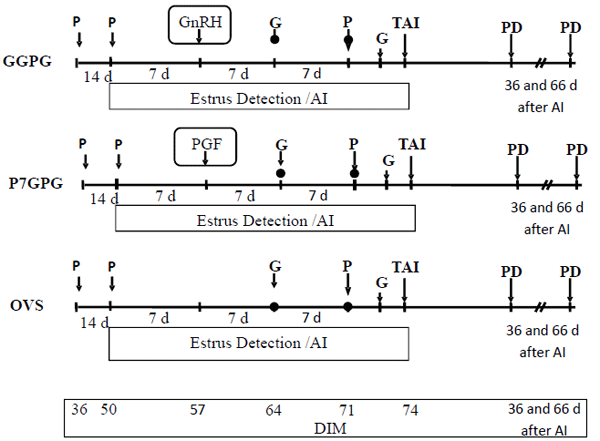
Figure 2. Kaplan-Mayer survival analysis illustrating the effect of synchronization programs (Experiment 1) on interval between voluntary waiting period (VWP) and AI for 1,521 cows enrolled in three synchronization programs for first AI. There was a difference in median days between VWP and first AI (OVS = 22, GGPG = 23 and P7GPG = 11 days, P < 0.001).
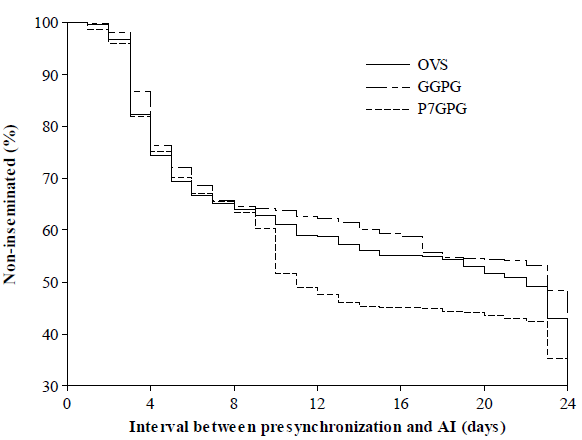
We concluded that reproductive programs for first AI must be selected by evaluating overall fertility outcomes which includes both cows detected in estrus and TAI cows if the dairy is utilizing estrus detection as part of their reproductive program. When a GnRH or PG injection was added in between the Presynch and Ovsynch program for first AI, P/AI was not altered but resulted in increased number of cows being AI upon estrus detection when PG injection was added or increased number of cows completing the TAI protocol when a GnRH injection was added 7 d after presynchronization. Dairy farms with good estrus detection and conception rates to those found in estrus, should take advantage of PG based synchronization programs since a higher percentage of cows would be AI upon estrus detection decreasing the cost and labor associated with TAI protocols.
Resynchronization Protocols Evaluated Without Estrus Detection
Resynchronization of non-pregnant cows continues to be a challenge for reproductive performance of dairy cows. According to published studies and on-farm data, P/AI of cows diagnosed not pregnant and resynchronized with the Ovsynch protocol is usually (< 30%). Many synchronization and resynchronization programs have been published over the past 15 years. However, until recently, almost all of these programs only evaluated TAI fertility and either did not do estrus detection or choose to ignore the cows the came into estrus. Below are a few of those studies.
Silva et al. (2007) evaluated a PG-based presynchronization protocol before the start of the resynchronization. Therefore, cows were examined for pregnancy at 32 d after AI. Half of the cows diagnosed not pregnant were submitted to the Ovsynch protocol starting at 33 d after AI and were reinseminated at 43 d after AI, whereas the other half of the cows were presynchronized with an injection of PG at 34 d after AI, were submitted to the Ovsynch at 46 d after AI and were reinseminated at 56 d after AI. The hypothesis was that by giving PG at 34 d after AI a large percentage of cows would start a new estrus cycle between 36 and 41 d after AI and consequently start the Ovsynch between d 5 and 10 of the estrous cycle. Pregnancy per AI (P/AI) was increased by presynchronizing cows with PG (35.2 vs. 25.6%). Interestingly, the percentage of cows that ovulated to the first GnRH injection of the Ovsynch was not different (53.9 vs. 49.3%) and, therefore, it was suggested that increases in P/AI may have been the result of improved uterine health because of the additional PG injection and the extra time between inseminations.
Giordano et al. (2012) compared the reproductive performance of cows resynchronized with the Ovsynch or Double-Ovsynch. Cows resynchronized with the Ovsynch received the first GnRH at 32 d after AI and, if diagnosed not pregnant at 39 d after AI, they received the PG at 39 d after AI, the second GnRH at 41 d and timed AI at 42 d. Cows resynchronized with the Double-Ovsynch received a GnRH at 22 d after AI, and if diagnosed not pregnant at 29 d after AI they received a PG, at d 32, at d 39 a GnRH, at d 46 a PG, at d 48 a GnRH, and at d 49 the timed AI. Cows resynchronized with the Double-Ovsynch were more likely to ovulate to the first GnRH (85.4 vs. 68.9%) and had greater P/AI (38.5 vs. 30.0%).
A critical issue with both of these protocols is that the interval between AI was increased by 7 d in both protocols, despite the fact that cows in the Double-Ovsynch treatment (Giordano et al., 2012) were examined for pregnancy by ultrasound 10 d earlier. One possible alternative to reduce the interval between AI when presynchronizing with a PG injection is to inseminate cows that display estrus during the 12 d before the start of the Ovsynch protocol.
A good alternative to presynchronize the estrous cycle of cows of unknown pregnancy status is to treat them with GnRH injection similar to the study mentioned previously for first postpartum TAI. Considering that cows with follicles > 10 mm in diameter are likely to ovulate to a GnRH injection, it is expected that GnRH given at random would result in ovulation in approximately > 40% of lactating dairy cows. Another alternative is to treat cows with a CIDR device during the resynchronization protocol because treatment with a CIDR device during a timed AI protocol results in improved synchronization of the estrous cycle. These alternatives were evaluated in a recent study conducted in AZ and CA (Dewey et al., 2010).
In this study, cows in the GGPG treatment were presynchronized with an injection of GnRH given at 32 d after AI and if diagnosed not pregnant on d 39 after AI they were submitted to the Cosynch72 (d 0 GnRH, d 7 PG, and d 10 GnRH+ timed AI). Cows in the CIDR treatment diagnosed not pregnant on d 39 after AI received the Cosynch72 with the addition of a CIDR device between the GnRH and the PG, given on d 0 and 7, respectively. The control treatment was the Cosynch72 protocol that started on d 39 after AI if cows were diagnosed not pregnant. The end result was greater P/AI for GGPG cows (31.2%) than control cows (22.1%). Further, CIDR cows (29.5%) had P/AI similar to that of GGPG cows and greater than control cows. The authors concluded that presynchronizing cows with a GnRH 7 d before the start of the resynchronization or treating cows with a CIDR device during the resynchronization protocol increased P/AI in nearly 8 percentage points without extending the interval between AI.
An interesting finding of this study is the small percentage (~ 25%) of cows that had luteolysis between the first GnRH injection (d 0) and the PG injection (d 7) of the Cosynch. The days when these injections were given would correspond, in cows with estrous cycle length of 22 d, to the beginning of the proestrus of the estrous cycle immediately after AI and early metestrus of the second estrous cycle after AI, respectively. This demonstrates that a large percentage of cows do not have the expected 22 d interval to return to estrus after a previous AI.
Resynchronization Protocols Evaluated With Estrus Detection
Although constantly new timed AI protocols are developed and evaluated, the importance of inseminating cows based on signs of estrus continues to be significant. Many dairies today utilize estrus detection as part of their reproductive program. Recently our group has evaluated the effects on fertility of integrating different resynchronization protocols into a reproductive program that utilizes estrus detection.
The first study evaluated the effects of 2 resynchronization timed AI protocols beginning at different intervals after AI on fertility in dairy cows (Bruno et al., 2013). Lactating cows from 2 dairies located in TX (n = 2233) and MN (n = 3077) were assigned to 1 of 4 timed AI protocols 17 ± 3 d after AI. Cows assigned to Early Resynch or Resynch received the OvSynch56 starting 24 or 31 d after AI, respectively. Cows assigned to Early GGPG or GGPG received a presynchronizing GnRH 17 or 24 d after AI, respectively, 7 d before the start of OvSynch56. Any cow observed in estrus was timed AI on the same day. Fewer Early GGPG (P<0.01) and more Resynch (P<0.01) cows were reinseminated in estrus (Early GGPG=23.7, GGPG=49.0, Early Resynch=41.6 and Resynch=57.6%). However, treatment did not affect (P=0.22) P/AI 66 d after re-insemination (Early Resynch=26.1, Early GGPG=29.4, GGPG=30.5, Resynch=30.4%). Cows re-inseminated in estrus, however, had greater P/AI at 66 d (36.0 vs. 23.9%) than cows that received timed AI. We concluded that early start of resynchronization and presynchronization with GnRH reduced number of cows re-inseminated in estrus and neither the timing nor the resynchronization protocol affected overall P/AI.
Since GnRH reduced the number of cows in estrus and increased the number of cows that entered the TAI program, which yielded a lower P/AI, then possibly utilizing a PG injection for presynchronization with estrus detection will improve fertility. A second study was conducted to determine the speed at which cows non-pregnant to a previous AI and that had their estrous cycle presynchronized with a GnRH or PG injection are re-inseminated and become pregnant (Chebel et al., 2012). Jersey (site A, MN) and Holstein (site B, WI) cows, 32 ± 4 d after AI, were assigned to one of two presynchronization treatments: GGPG (n = 452) – GnRH injection at enrollment (d 0), 7 d before the start of the timed AI protocol; and, P11GPG (n = 466) – PG injection on d 3, 11 d before the start of the timed AI protocol. Cows observed in estrus at any interval after enrollment were re-inseminated on the same day. Timed AI protocols were the Ovsynch56 in site A and the Cosynch48 in site B. Cows in herd A were examined by ultrasound 32 ± 4 d after AI and those diagnosed non-pregnant continued in the experiment (n = 611), whereas cows (n = 875) in herd B had blood samples collected on the day of enrollment (32 ± 4 d after AI) and analyzed for concentration of pregnancy specific protein-B (PSPB; Biopryn). PSPB results were received 2.5 d after enrollment, thus cows in herd B enrolled in the GGPG treatment received the presynchronizing GnRH injection at enrollment without previous knowledge of pregnancy status. However, cows in herd B enrolled in the P11GPG treatment only received PG if diagnosed non-pregnant, 2.5 d after enrollment. Cows in the P11GPG treatment had faster re-insemination rate (Figure 3) and were less likely to be submitted to the timed AI protocol (40.3 vs 89.8%) and to be re-inseminated at fixed time (38.6 vs 83.9%) as shown in table 1. Consequently, the interval from enrollment to reinsemination was shorter for P11GPG cows than GGPG cows (Table 1 and Figure 3). Percentages of cows pregnant at 67 ± 4 d after re-insemination were not affected by resynchronization protocol; however, pregnancy rate from d 0 to 7 and from d 8 to 14 was greater for P11GPG cows (Table 1). The increased pregnancy rate illustrates the expedited re-insemination rate and establishment of pregnancy for cows injected with PG. Authors concluded that fertility of non-pregnant cows that had their estrous cycle presynchronized with GnRH or PG was not different, but in herds with adequate estrous detection efficiency and accuracy, presynchronization with PG is likely to reduce the interval to establishment of pregnancy and to reduce the cost of resynchronization protocols.
It is important to note that, according to data from herd A, P/AI 32 ± 4 d after re-insemination tended to be (P = 0.10) affected by the interaction between presynchronization treatment and presence of CL on the day of enrollment. Cows in the GGPG treatment with a CL on the day of enrollment (CL+) had similar P/AI compared with P11GPG/CL+ cows (34.1 vs 32.7%, respectively). On the other hand, GGPG cows without a CL on the day of enrollment (CL-) had greater P/AI than P11GPG/CL- cows (44.4 vs 25%). This numerical difference was carried out to 67 ± 4 d after reinsemination (GGPG/CL+ = 30.8%, P11GPG/CL+ = 29.9%, GGPG/CL- = 37.7%, P11GPG/CL- = 22%), but there was no statistical significance (P = 0.22). This illustrates a possible advantage of ultrasound exam for diagnosis of non-pregnancy and ovarian structures, which would allow a more judicious decision regarding the resynchronization protocol for specific cows. Samples submitted for PSPB analysis, however, could also had been analyzed for progesterone (P4) concentration determining the best resynchronization protocol on presence (P4 ≥ 1 ng/mL) or absence (P4 < 1 ng/mL) of a viable CL. An obvious disadvantage of the PSPB test is the fact that results are not known up to 48 to 72 h after sample collection, which may extend the interval between inseminations.
Table 1. Effect of GGPG or P11GPG on pattern of re-insemination, pregnancy per AI (P/AI) after re-insemination, and pregnancy rates.
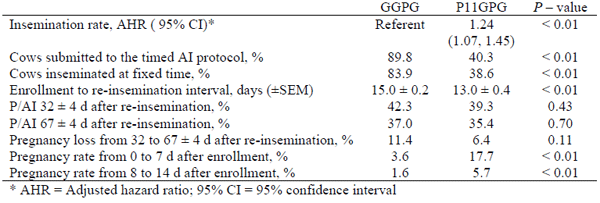
Figure 3. Survival analysis of interval from enrollment to re-insemination according to presynchronization treatment (Wilcoxon test of equality – P < 0.01).
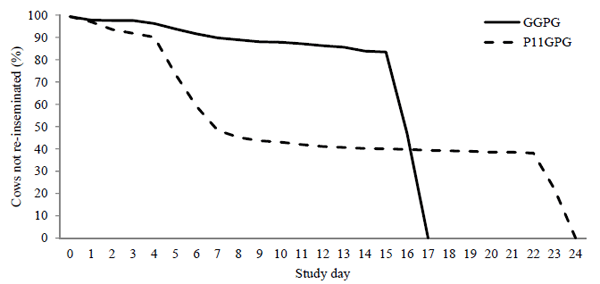
Lastly, an experiment was conducted to evaluate the use of PG at different intervals prior to resynchronization programs on fertility in lactating dairy cows (Bruno et al., 2013). Cows (n = 2,327) were assigned to 1 of 3 resynchronization protocols 7 d prior to non-pregnancy diagnosis which is also experimental d 0: GGPG (n = 458), received a GnRH at enrollment (d 0) and OVS (GnRH 7 d later PG, 56 hrs GnRH, and 16 hrs later TAI) at non-pregnancy diagnosis 7 d later; P7GPG (n = 940) received a PG at non-pregnancy diagnosis and OVS 7 d later; and P11GPG (n = 929) received a PG 3 d after non-pregnancy diagnosis and OVS 11 d later. The GGPG protocol reduced estrus detection and treatment did not affect overall P/AI at 66 d after AI or pregnancy loss (Table 2). Cows AI upon estrus detection had greater P/AI then cows TAI (estrus detection = 32.3, TAI = 25.1%). However, treatment did not affect P/AI for cows AI upon estrus detection 66 d after AI or TAI (Table 2). Median days between non-pregnancy diagnosis and AI was affected by treatment (GGPG = 10 vs. P7GPG = 4 and P11GPG = 7 d; Figure 4). This reinforces the fact that PG based programs increased estrus detection and reduced interval to first AI and between AI while GnRH based programs increased the proportion of cows TAI. Also, cows AI upon estrus detection had increased P/AI than cows TAI. Interestingly, shortening the interval from PG to the initiation of resynchronization did not negatively affect fertility at TAI and reduced interval to AI. However, caution should be taken when utilizing PG 7 d prior to resynchronization if estrus detection is NOT used as the majority of the cows would be at the incorrect stage of the estrous cycle when beginning resynchronization.
Table 2. Effect of different presynchronization treatments and intervals on reproductive outcomes
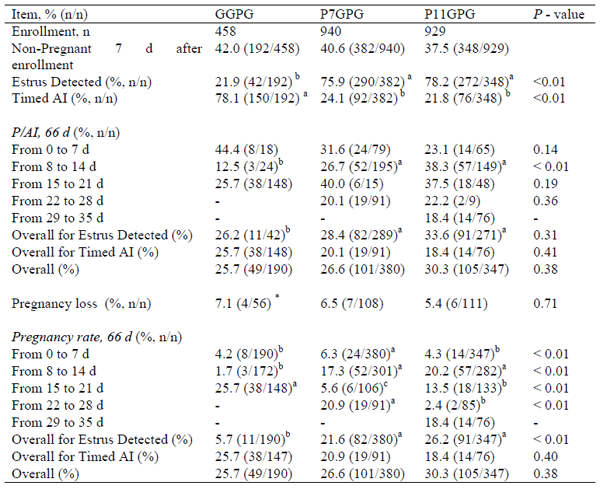
Figure 4. Kaplan-Mayer survival analysis illustrating the effect of resynchronization programs on interval between study enrollment and subsequent AI for 3 resynchronization programs.
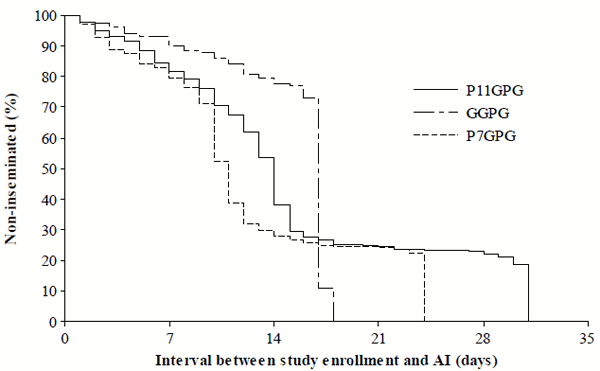
These studies illustrate how the number of cows detected in estrus is affected by timing of GnRH or PG injections and that caution should be exercised when recommending synchronization programs based on GnRH particularly to herds with good AI submission rates and good P/AI to cows inseminated in estrus. Furthermore, if no benefits to overall reproductive performance are achieved by implementing protocols that reduce estrous expression, a significant increase in cost of reproductive programs will be observed because greater percentage of cows have to be enrolled in fixed time AI protocols. Therefore, it may be advantageous for farms with acceptable estrus detection and conception rates to utilize synchronization programs that are PG based (i.e. P7GPG, P11GPG) compared with GnRH based protocols (i.e. GGPG, G6G or Double-Ovsynch) due to the effects that these protocols have on reducing estrus. For example, in the study by Bruno et al. (2012, 2013) cows re-inseminated in estrus had P/AI 12 and 7 percentage units greater than cows that were re-inseminated at fixed time, respectively. Some of this reduction is possibly due to a less fertile population of cows entering the synchronization protocol due to the more fertile cows displaying estrus and removed from the synchronization protocol.
Insemination based on signs of estrus during synchronization protocols
Although constantly new timed AI protocols are developed and evaluated, the importance of inseminating cows based on signs of estrus continues to be significant. In some situations the dairy may have facility limitations, not enough personnel, poor estrous expression, poor conception rates to cows detected in estrous or simple preference to not allow for daily observation of estrus and insemination so 100% timed AI protocols may be necessary. In herds with adequate estrus-detection accuracy it is expected that P/AI of cows inseminated in estrus to be similar or greater than that of cows inseminated at fixed time.
In a recent study with 3,248 lactating dairy cows conducted in 7 large dairy herds across the US, cows were presynchronized with two injections of PG and those observed in estrus were inseminated (Chebel et al., 2010a; Figure 5). Cows not observed in estrus were submitted to a timed AI protocol (i.e. Ovsynch or Cosynch72). These herds were a mix of dry-lot (AZ and CA1) and free-stall (remaining herds). The average days in milk at first AI were 58.3 ± 0.2 and 73.3 ± 0.2 for cows inseminated in estrus and those inseminated at fixed timed AI, respectively. Cows inseminated in estrus after the second injection of PG of the Presynch protocol had P/AI that ranged from 25.3 to 41.2% and in only 2 of the 7 herds P/AI of cows inseminated in estrus was smaller than that of cows inseminated at fixed time (range – 22.4 to 46.9%).
Figure 5. AI submission rate and pregnancy per AI (P/AI) of cows inseminated on estrus (Estrus) or timed AI (TAI). All cows were presynchronized with the Presynch protocol and those not observed in estrus within 12-14 d after the last PG injection of the Presynch were enrolled in a timed AI protocol (Chebel et al., 2010a).
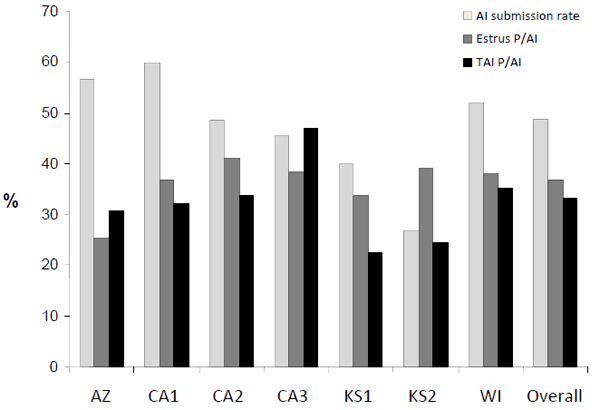
In another study, Chebel et al. (2010b) evaluated the reproductive and economic performances of cows submitted to the Presynch-Ovsynch with or without ‘cherry-picking’ (insemination of cows that displayed estrus between the second PG of the Presynch and beginning of the Ovsynch). In this study, P/AI after first AI was not different between cows in the ‘cherry-picking’ and ‘100% timed AI’ protocols (Table 3).
Table 3. Effect of inseminating cows in estrus following a presynchronization protocol on reproductive and economic performance of lactating Holstein cows.

Furthermore, when the rate at which cows became pregnant was evaluated (Figure 6), it was evident that inseminating 100% of cows at fixed time did not improve reproductive efficiency significantly to pay for the additional cost of first AI synchronization protocols.
Figure 6. Effect of ‘cherry-picking’ after the Presynch on interval from parturition to pregnancy (P = 0.22). Mean (±SEM) and median interval from parturition to establishment of a new pregnancy: ‘Cherry-picking’ = 154.0 ± 4.7 and 125 and ‘100% Timed AI’ = 153.4 ± 4.2 and 134.5.
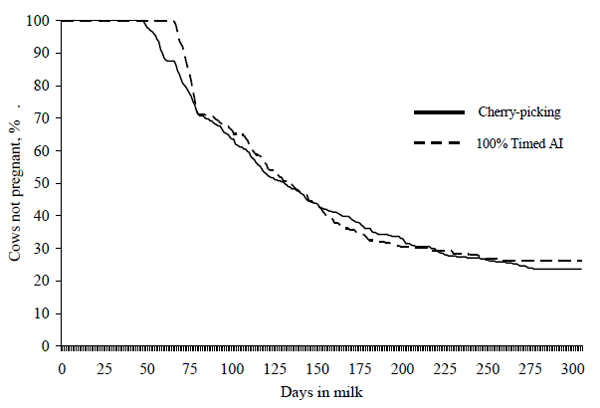
When data from 5 different studies conducted in 4 different farms in CA were combined, the P/AI of cows inseminated at estrus after the presynchronization protocol (i.e two injections of PG 14 d apart) was approximately 2.5% units greater than those inseminated at fixed timed AI (34.9 vs. 32.5%; Santos et al., 2007). Other studies have demonstrated a slight increase in P/AI of cows inseminated at fixed timed AI compared with those inseminated at estrus (28.3 vs. 31.5%; Stevenson and Phatak, 2005).
The importance of inseminating cows in estrus becomes even more important when dealing with reinsemination. In the study by Dewey et al. (2010), cows that displayed estrus from 32 to 46 d after previous AI and were re-inseminated had P/AI = 37.1%, whereas cows re-inseminated at fixed time (on d 49 after previous AI) had P/AI = 28.4%. The findings of the study by Dewey et al. (2010) are reinforced by on-farm data. Below (Table 4) is the P/AI of cows re-inseminated based on signs of estrus or at fixed time in 4 herds across the US (data extracted from Dairy Comp 305).
Table 4. Pregnancy per AI (P/AI) of cows re-inseminated based on signs of estrus or at fixed time

Timing of pregnancy diagnosis when initiating resynchronization
Another consideration for when and what synchronization program to utilize is the timing of pregnancy diagnosis. Research continues to explore ways to reduce the interval between inseminations to increase the number of cows pregnant and reduce the number of days open. Several alternatives for pregnancy diagnosis are currently available such as utilizing blood pregnancy tests as early as d 28 post AI. Also, ultrasonography can be utilized at approximately 27 d post AI and transrectal palpation is normally recommended at 32 d post AI or greater depending on technician skill level.
Most dairies initiate their resynchronization program either prior to or at non-pregnancy diagnosis. The time at which pregnancy diagnosis occurs and subsequently initiation of the synchronization program may reduce estrus expression depending on the timing and type of hormonal injection utilized as shown above. For example, in the (Bruno et al. 2011) study, if the first GnRH of GGPG began at 17 d after TAI versus waiting until 24 d after TAI, estrus detection was reduced by 25 percentage units (24 % vs. 49%). Previous research has shown that >50% of the animals show estrus after day 21 with the greatest amount occurring before d 25 (Chebel et al., 2006). Also, if GnRH is utilized as a presynchronization tool instead of PG, number of cows detected in estrus can be reduced from 78% to 24% after injection. In turn more cows would enter the synchronization program and receive timed AI. This may reduce fertility and increase drug costs if your estrus detected cows can achieve conception rates similar to or greater than timed AI. If synchronization protocols are implemented based on when non-pregnancy diagnosis occurs caution should be given to the type of protocol utilized and timing of pregnancy diagnosis to maximize fertility and profitability.
Activity Monitors and Synchronization
Recently studies were conducted to determine whether activity monitors could eliminate the need for time AI protocols completely. Two recent experiments, however, indicated that activity monitors are not able to achieve AI submission rates of > 85% as some companies were claiming for the simple fact that some cows will not display estrus. Valenza et al. (2012) fitted 42 cows with an activity monitor system (collar) and a mounting detection system (Kamar). The cows were synchronized and allowed to come in estrus. Cows were then examined by ultrasound to determine ovarian activity and occurrence of ovulation. In this small experiment, according to activity monitor and mounting detector 67 and 62%, respectively, of cows were observed in heat and ovulated; 7 and 12%, respectively, of cows were not observed in heat and ovulated; 5% of cows were observed in heat and did not ovulate; and, 21% of cows were not observed in heat and did not ovulate. Therefore, based on an activity monitor system and a mounting detection system 28 to 33%, respectively, of cows were not observed in estrus. Furthermore, considering ovulation as the ‘gold standard’, cows that ovulated and were in estrus were +/+, cows that did not ovulate and were in estrus were -/+, cows that ovulated and were not in estrus were +/-, and cows that did not ovulate and were not in estrus were -/-. Thus, the activity monitor system and the heat detection system resulted in sensitivity of 91 and 84%, respectively, specificity of 81%, positive predictive value of 93%, and negative predictive value of 75 and 64%, respectively. Therefore, based on this small experiment the activity monitor and mounting detection system had similar performance.
In a study presented at the 2012 American Dairy Science Association, researchers evaluated the insemination pattern and P/AI of cows that were fitted with activity monitors and were submitted to the Ovsynch protocol with estrus detection, to the Presynch/Ovsynch with estrus detection, and to the Presynch/Ovsynch protocol without estrus detection (100%TAI; Fricke et al., 2012). In this study, 70% of cows that received the two PG presynchronizing injections were observed in estrus, whereas approximately 57% of cows that were not presynchronized with PG were observed in estrus. The P/AI of cows inseminated in estrus was 30% and the P/AI of cows inseminated at fixed time was 36%. These numbers are very similar to those reported by Chebel et al. (2006, 2010b) and Lima et al. (2009). In these studies the percentage of cows that were inseminated in estrus after two presynchronizing injections of PG ranged from 50 to 62%. On the other hand, P/AI of cows inseminated in estrus ranged from 27 to 44% and P/AI of cows inseminated at fixed time ranged from 21 to 41%. The results from these studies suggest that activity monitors may perform just as well as detection of estrus based on tail paint removal and that P/AI of cows inseminated in estrus based on activity or tail paint removal may be similar, these being extremely dependent on farm and personnel.
Field observations of two herds that adopted the activity monitor systems for estrus detection and abolished the use of fixed time AI for first postpartum AI demonstrate that there is a significant risk of increasing significantly the variability in interval to first AI, increasing interval to first postpartum AI, and reducing AI submission rate and pregnancy rate. Although this was not data from controlled studies, it was possible to observe that once timed AI protocols stopped being used in the herds that adopted the activity monitoring system their pattern of first postpartum AI started to resemble the pattern of first postpartum AI before timed AI protocols were widely adopted.
Conclusion
Strides continue to be made in improving fertility to synchronization programs. Using presynchronization protocols before the start of a synchronization program improves fertility compared with cows initiating the synchronization program at random stages of their estrous cycle. Presynchronization with a GnRH injection will reduce the number of cows displaying estrus and increase the number of cows which receive TAI. However, the opposite will occur when utilizing a PG injection which is an important consideration if a dairy farm is utilizing estrus detection. Timing of GnRH injections prior to resynchronization can greatly reduce number of cows detected in estrus if given before d 25. Activity monitors are an additional tool which can aid in improving estrus detection; however, it does not observe 100% of the cows in estrus so a robust synchronization program is still important to use as an insurance tool to insure that all cows receive TAI by a certain DIM. Future studies should continue to focus on improving TAI fertility without negatively affecting the number of cows displaying estrus.
References
Bello, N.M., J.P. Steibel and J.R. Pursley. 2006. Optimizing ovulation to first GnRH improve outcomes to each hormonal injection of Ovsynch in lactating dairy cows. J. Dairy Sci. 89:3413-3424.
Bruno, R.G.S., J. G. N. Moraes, J. A. Hernández-Rivera1, K. J. Lager, P. R. B. Silva, A. L. A. Scanavez, L. G. D. Mendonça, R.C. Chebel, and T. R. Bilby. 2011. Comparison of two resynchronization protocols initiated at different intervals after insemination on fertility in lactating dairy cows. J. Dairy Sci. 94(Suppl-1) pg 82.
Bruno, R.G.S., A.M. Farias, K.J. Lager, A.E. Navarrette, D.E. Hawkins and T.R. Bilby. 2013. Effect of GnRH or PGF2α based estrus synchronization programs for first or subsequent AI in lactating dairy cows. J. Dairy Sci. (in press).
Caraviello, D.Z., K.A. Weigel, P.M. Fricke, M.C. Wiltbank, M.J. Florent, N.B. Cook, K.V. Nordlund, N.R. Zwald, and C.L. Rawson. 2006. Survey of management practices on reproductive performance of dairy cattle on large US commercial farms. J Dairy Sci. 89:4723-4735.
Cerri, R.L.A., H.M. Rutigliano, R.C. Chebel, and J.E.P. Santos. 2009. Period of Dominance of the Ovulatory Follicle during Synchronization Programs Influences Embryo Quality. Reproduction 137:813-823.
Cerri, R. L. A., H. M. Rutigliano, R. G. S. Bruno, and J. E. P Santos. 2009. Progesterone concentration, follicular development and induction of cyclicity in dairy cows receiving intravaginal progesterone inserts. Anim. Reprod. Sci., 110:56-70.
Chebel R.C., J.E.P. Santos, R.L.A. Cerri, H.M. Rutigliano, and R.G.S. Bruno. 2006. Reproductive performance of lactating dairy cows following progesterone insert based presynchronization and resynchronization protocols. J. Dairy Sci 89: 4205-4219.
Chebel, R.C., F.A. Braga, and J.C. Dalton. 2007. Factors affecting reproductive performance of Holstein heifers. Anim. Reprod. Sci. 101(3-4): 208–224.
Chebel, R.C., F. Rivera, C. Narciso, W.W. Thatcher, and J.E.P. Santos. 2008. Effect of reducing the period of follicle dominance in a timed AI protocol on reproduction of dairy cows. J. Dairy Sci. (Abstr.).
Chebel, R.C., M.J. Al-Hassan, P.M. Fricke, J.E. Santos, C.A. Martel, J.S. Stevenson, R. Garcia, R.L. Ax, F. Moreira. 2010a. Supplementation of progesterone via CIDR inserts during ovulation synchronization protocols in lactating dairy cows. J. Dairy Sci. 93(3):922-931.
Chebel, R. C., and J.E.P. Santos. 2010b. Effect of Inseminating Cows in Estrus Following a Presynchronization Protocol on Reproductive and Lactation Performances. J. Dairy Sci. (in review)
Chebel, R.C., A.A. Scanavez, P.B. Silva, J.G.N. Moraes, L.G.D. Mendonca, and G. Lopes Jr. 2012. Evaluation of presynchronized resynchronization protocols for lactating dairy cows. J. Dairy Sci. (in press)
Dewey, S.T., L.G.D. Mendonca, G. Lopes Jr., F. A. Rivera, F. Guagnini, R.C. Chebel, and T.R. Bilby. 2010. Resynchronization strategies to improve fertility in lactating dairy cows utilizing a presynchronization injection of GnRH or supplemental progesterone: I. Pregnancy rates and ovarian responses. J. Dairy Sci. 93:4086-4095.
Fricke, P.M., A. Valenza, J.O. Giordano, M.C. Amundson, and G. Lopes Jr. 2012. Reproductive performance of lactating dairy cows managed for first service using timed artificial insemination with or without detection of estrus using an accelerometer system. J. Dairy Sci. 95:(Suppl. 2) pg. 74.
Galvão, K.N., M.F. Sá Filho, and J.E. Santos. 2007. Reducing the interval from presynchronization to initiation of timed artificial insemination improves fertility in dairy cows. J Dairy Sci. 90:4212- 4218.
Giordano, J.O., M.C. Wiltbank, J.N. Guenther, M.S. Ares, G. Lopes Jr., M.M. Herlihy and P.M. Fricke. 2012. Effect of presynchronization with human chorionic gonadotropin or gonadotropinreleasing hormone 7 days before resynchronization of ovulation on fertility in lactating dairy cows.
Lima, J.R., F. Rivera, C. Narciso, R. Oliveira, R.C. Chebel, J.E.P. Santos. 2009. Effect of Concentrations of Progesterone During a Timed AI Protocol on Fertility of Lactating Dairy Cows. J. Dairy Sci. 92(11):5436-5446.
Moreira, F., Orlandi, C., Risco, C.A., Mattos, R., Lopes, F., Thatcher, W.W. 2001. Effects of presynchronization and bovine somatotropin on pregnancy rates to a timed artificial insemination protocol in lactating dairy cows. J. Dairy Sci. 84, 1646–1659.
Pursley, J. R., M. O. Mee, and M. C. Wiltbank. 1995. Synchronization of ovulation in dairy cows using PGF2alpha and GnRH. Theriogenology 44:915-923.
Silva, E., R.A. Sterry, D. Kolb, M.C. Wiltbank and P.M. Fricke. 2007. Effect of prostaglandin F2α before resynchronization of ovulation on fertility of lactating dairy cows. J. Dairy Sci. 90: 5509- 5517
Souza, A.H., H. Ayres, R.M. Ferreira, and M.C. Wiltbank. 2008. A new presynchronization system (Double-Ovsynch) increases fertility at first postpartum timed AI in lactating dairy cows. Theriogenology 70:208-215.
Stevenson J. S. and A. P. Phatak. 2005. Inseminations at estrus induced by presynchronization before application of synchronized estrus and ovulation. J. Dairy Sci. 88:399 - 405
Vasconcelos, J. L., R. W. Silcox, G. J. Rosa, J. R. Pursley, and M. C. Wiltbank. 1999. Synchronization rate, size of the ovulatory follicle, and pregnancy rate after synchronization of ovulation beginning on different days of the estrous cycle in lactating dairy cows. Theriogenology 52: 1067-1078.
Valenza, A., J. Giordano, G. Lopes Jr., L. Vincenti, M. Amundson, and P. Fricke. 2012. Assessment of an accelerometer system for detection of estrus and treatment with GnRH at the time of insemination in lactating dairy cows. J. Dairy Sci. (in press)
This paper was presented at the 2013 Western Dairy Management Conference is March 6-8 at John Ascuaga's Nugget, Reno, NV. Engormix thanks for this contribution.
Related topics:
Authors:
MSD - Merck Animal Health

Recommend
Comment
Share
18 de febrero de 2014
we in the northern part of Pakistan (provincial Territory) bordering with Afghanistan are just preparing to start such trial with a small breed of cattle namely Achai with a subsistence farmers. the project is financed by the Federal Government from the Agriculture linkages program ALP by National Agriculture Research Council & and Pakistan Agriculture Council of Pakistan (NARC/PARC)whose results will be shared with this forum. The instant article would help us in pursuing our own at this end definitely.
Recommend
Reply

Would you like to discuss another topic? Create a new post to engage with experts in the community.





